If you’re newer to fishing, you’ve probably heard the terms “plug” or “crankbait”. So exactly what is a crankbait? And why should you learn to use them?
Crankbaits are hard-bodied lures that do two things exceptionally well. One, they dive to specific depths in the water column based on the shape and size of the bill. Two, they mimic the shape and movement of small fish and forage of larger predator fish like bass.
These two simple things make crankbaits some of the most effective fish-catching lures you can use.
Dive to Depth + Match the Forage = Catching Fish
Crankbaits are made in a vast array of shapes, sizes, colors, and bill styles. Trying to choose the right type of crankbait can be intimidating when you are just starting out.
This guide will teach you the strengths and weaknesses of each type of crankbait so you can pick the right lure for the job.
Features of a Crankbait
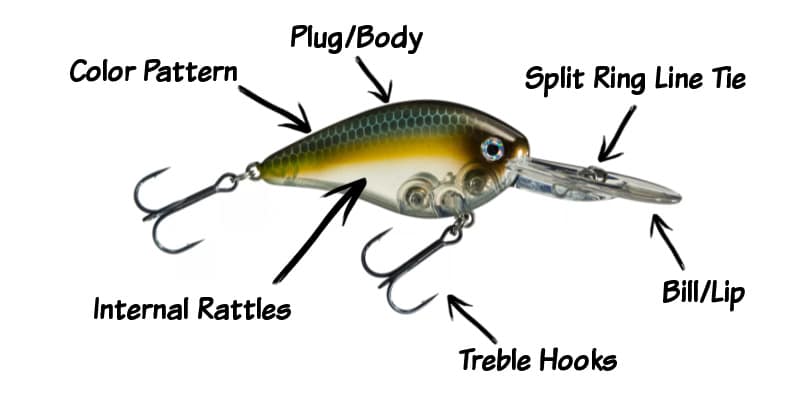
It is useful to define the parts of a crankbait as we break down all the differences between the types.
- Plug/Body – Made of rigid plastic or floating wood like balsa or cedar.
- Bill/Lip – The bill creates diving and wobbling action. Shapes and sizes can vary, creating different actions and diving depths underwater.
- Line Tie – The split ring where the line is tied, or a snap is attached.
- Internal Rattles – Many crankbaits use rattles to attract the attention of fish. They also help balance the lure and increase casting distance.
- Treble Hooks – Crankbaits always use 2 treble hooks, increasing in size with the lure. Why only 2? More than two and the action is ruined and can reduce the chances of hooking the fish.
- Color Pattern – Crankbaits are made in every color imaginable, from solid colors, and flashy chromes, to ultra-realistic. A good rule of thumb is to choose colors that imitate what your local fish eats. Shad, Bluegill, or Crawfish pattern crankbaits are a great place to start.
Types of Crankbaits
Crankbaits are used for targeting fish that are feeding at specific depths on baitfish and forage. This makes it helpful to group crankbait types based on how deep they dive in the water.
There are a few additional styles that are unique and deserve their own category. Then you can choose the type of bill based on the type of cover in the water you like to fish.
1. Shallow Diving (0-5 feet)
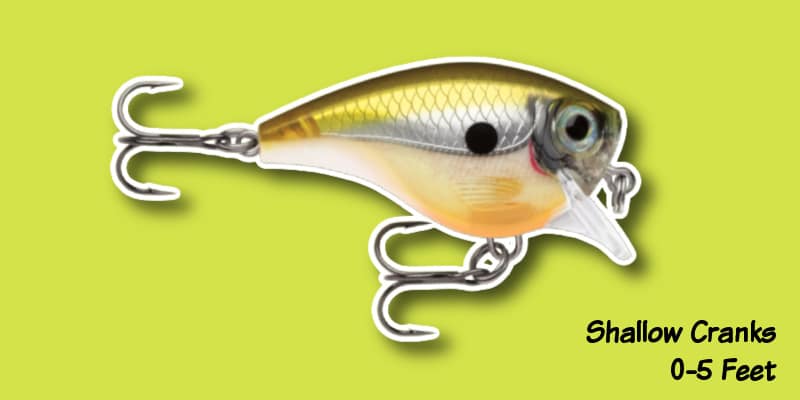
Shallow diving crankbaits can be characterized by smaller bodies (less than 2.5”), short steep angled lips, a line tie near the nose of the lure, and weighing less than ½ oz.
The stubby bills and close line tie limit the maximum depth the crankbait can reach and create a wider wobbling action. These are good features to have at very shallow depths where you want to trigger a reaction strike from fish looking for an easy meal.
Where to Use a Shallow Diving Crankbait
- Hard Bottom Banks
- Shallow Points
- Rip Rap Banks
- Shad Spawn
- Culverts and Eddys
- Shallow Vegetation
2. Medium Diving (5-12 feet)

Bass do not always stay in shallow water. Before and after the spawn (Pre-Spawn & Post-Spawn), bass will slide out to the next deepest water from their spawning grounds. These areas frequently fall within the 5 to 10 feet depth range.
Medium divers are longer lipped than shallow divers, and the line tie moves away from the plug body to generate more diving depth. These baits measure 2 to 3 inches long and weigh 3/8 to ¾ ounces.
Where to Use a Medium Diving Crankbait
- Points
- Roadbeds
- Shallow Ledges
- Brush Piles
- Shell Beds
- Weed Edges
3. Deep Diving (12-20 feet)

During the summer when the water gets warm and less rich with oxygen, bass will move to deeper water and structure.
When worms and big jigs aren’t getting bites, a deep-diving crankbait is an excellent lure to reach those depths and trigger those fish to bite.
Deep divers are 3 to 4 inches in length, with large round bills, and weigh ¾ to 1 ounce, so you better have the right gear to throw these big baits all day.
A dedicated glass crankbait rod and large spool cranking reel are essential to making long casts and efficiently working them down to 20 feet of water.
Where to Use a Deep Diving Crankbait
- Deep Points
- Deep Rock Piles
- Humps
- Ledges
- Bridge Pilings and Road Beds
4. Extra Deep Diving (20+ feet)
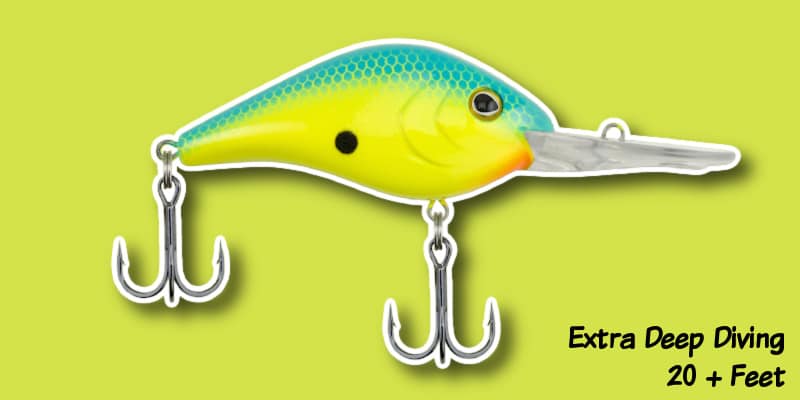
On some bodies of water, the fish can get really deep. If shad and bait go deep during the hot months, and as long as the thermocline cooperates, bass can school up beyond the 20-foot range.
Many times, these fish are not very active, and a deep-diving crankbait is the only way to trigger a reaction bite.
Extra deep diving cranks are really big lures. A Strike King 10XD for example is 6 inches long and weighs almost 2 ounces. You’ll need a swimbait-sized rod and reel to launch these baits a good distance.
An oversized casting reel with an oversized spool (filled with 15lb fluorocarbon) and big handles are necessary to fish extra deep divers.
Where to Use a Deep Diving Crankbait
- Deepest Points
- Deepest Rock Piles
- Extra Deep Humps
- Steep Ledges
- Old Bridges
5. Squarebill Crankbaits (2-10 feet)

Squarebills are distinctive for their flattened “squared-off” leading edge on the bill. This bill shape has proven to be excellent at deflecting off underwater objects like brush piles, tree limbs, stumps, and rocks.
Why is deflection important? First of all, it keeps your bait from constantly snagging in the cover. Second, and most importantly, this erratic deflecting movement can trigger vicious bites from largemouth bass hiding out in these areas.
Squarebills are generally considered a shallow running crankbait, but newer versions can reach depths of 10 to 12 feet, great for reaching deeper brush piles and even for shallower ledges and shell beds.
Where to Use a Squarebill Crankbait
- Shallow Stump Fields
- Laydowns (Blown down trees)
- Brush Piles
- Shell Beds
- Shallow Rock and Gravel
- Dingy, Murky Water Clarity
6. Lipless Crankbaits (Sinking)
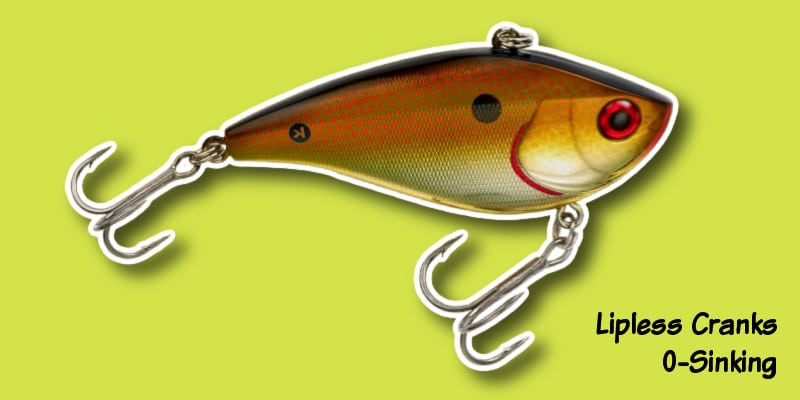
Lipless crankbaits have similar profiles to lipped crankbaits, but from the front, they are narrow and flat-sided. The lip is built into the front of the crankbait, creating a very fast, tight wobble compared to standard cranks.
Lipless cranks are sinking lures that can be fished at a variety of depths. Make long casts and let it sink to the target depth before starting your retrieve. Being able to sink also lets you yo-yo or rip the bait up and down, creating a loud vibration, something impossible to do with a lipped bait!
The sinking action and tight vibration make lipless crankbaits excellent search baits. When you aren’t quite sure where or at what depth the bass are, covering lots of water with a lipless bait can help you quickly narrow down the possible locations.
Where to Use a Lipless Crankbait
- Grass Flats
- Weed Edges
- Rock and Gravel Flats
- Searching for Fish in Spring and Fall
7. Flat Side Crankbaits (3-12 feet)
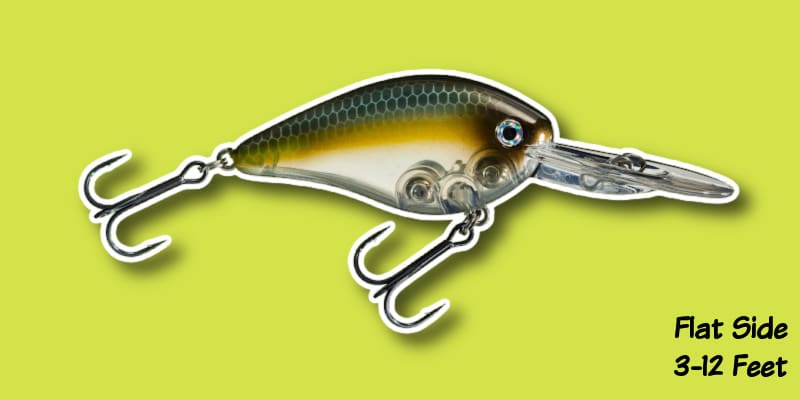
A flat-sided crankbait looks a lot like a regular crankbait, with flatter sides. They are not as flat as a lipless crank, and they have a standard round bill.
The flat body and shorter round bill create a tighter wobble, which is known to work well when the water is colder in spring and fall. This is a very underrated crankbait for bass.
Flat side crankbaits also work really well around grass and weeds. For some reason, perhaps the more subtle wobble, they seem to come through the weeds a little better than a regular medium diver. Give one a try on the eelgrass, milfoil, or hydrilla edges and you’ll see what I mean.
Where to Use a Flat Side Crankbait
- Grass Edges – Eelgrass, Hydrilla, Milfoil
- Rock and Gravel Flats
- Tree Limbs & Timber
- Creek Channel Turns
- Cold Water Temperature/Cold Weather
8. Balsa Crankbaits
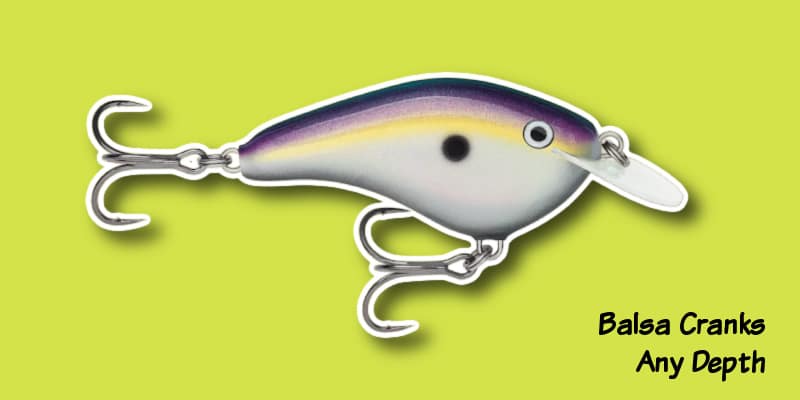
Even though it’s light and soft, Balsa is still considered a hardwood. Balsa woods’ strong yet lightweight properties are ideal for making crankbaits of all types.
Balsa is more buoyant than plastic so they have great action underwater, especially balsa squarebills and flat-sided crankbaits. In fact, flat-side balsa baits like the Rapala Shad Rap are considered some of the best cold-water baits you can throw.
Rapala and Bagley are among the few manufacturers making balsa crankbaits, mostly due to the material costs. Rapala DT Series crankbaits are quite possibly the most popular balsa crankbaits right now, they are that good.
Where to Use a Balsa Crankbait
- Anywhere you Fish a Squarebill
- Weed Edges
- Rock and Gravel
- Cold Water/Cold Weather
6 Crankbait Bill Types
An important aspect of mastering different crankbait types is understanding the types of bills and their strengths. Each bill shape has a unique action and reaction to hitting objects underwater. Choosing the right bill type for your specific body of water will increase your chances of success.
1. Round Bill
A round bill is the standard shape for crankbaits. It gives a crankbait a wide wobbling action. In general, the longer the bill, the deeper the crankbait will dive. The wider and rounder the bill, the wider the side-to-side wobble movement.
2. Square Bill
Deflection is the key with a square bill. It doesn’t matter if short and stubby, or a bit longer like round bills, the idea is to crash the lure into the cover and the bill allows it to bounce and deflect away. This looks like food trying to escape, and bass can’t stand it.
3. Coffin Bill
The coffin bill gets its name from the, ahem, coffin-like outline when viewed from the front of the bait. A squared-off front edge with angled corners. This hybrid type of bill provides deflecting capabilities of a square bill and the ability to dive deeper like a round billed crankbait.
4. Circuit Board
Circuit Board lips are made of tough thin pieces of material that feel a lot like a fiberglass circuit board. They are opaque and completely flat, as opposed to the transparent Lexan bills.
Circuit board crankbaits, like the Rapala OG Slim, are known to rebound sharply when crashing into hard objects, especially rocks. If you like to fish in rocky rivers, a circuit board crankbait is a great choice.
5. L Bill
L bill crankbaits are shallow runners, down to 5 feet deep, featuring a wide erratic “hunting” action. They excel at both deflecting off shallow cover and fishing over the top of shallow submerged grass.
On one hand, you can fish them much like you do a lipless bait, burning and ripping off the grass. On the other, you can fish it like a squarebill and get a wild and erratic hunting action on the deflections.
The most popular example is the Strike King Hybrid Hunter, which has built a reputation for coming through weeds well and catching bass in shallow water.
6. Cupped Bill
A cupped bill creates an erratic, unpredictable wobble action. The sudden elusive movement can be enough to turn the following fish into a bite.
The most popular cupped bill crankbaits are the Rapala Scatter Rap Crank. They dive to the 6-8 foot depth range and are a great alternative to a squarebill in those shallow to medium depths.
Putting it All Together
Fishing crankbaits is something every bass angler should learn. Like every technique, there is a learning curve, and understanding the types of crankbaits and bill shapes is just the first step.
You need to get on the water and try the different styles, learn how they feel, how to reduce snags, and how to unsnag your lure. You will develop a feel and sense for what your lure is hitting, and soon after how to trigger some crushing reaction bites!
Once you get hooked on crankbait fishing, there’s no turning back!

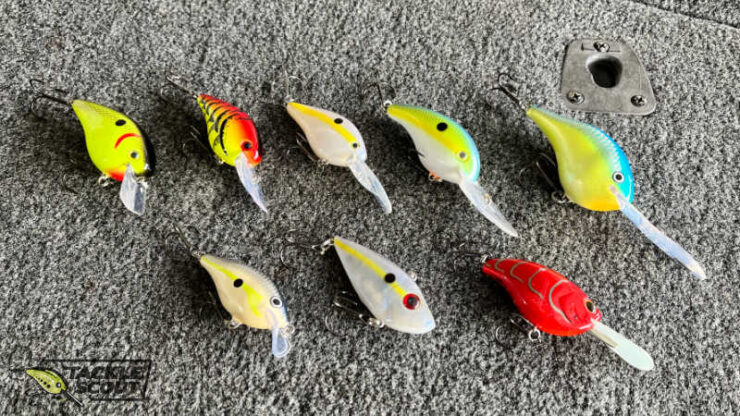
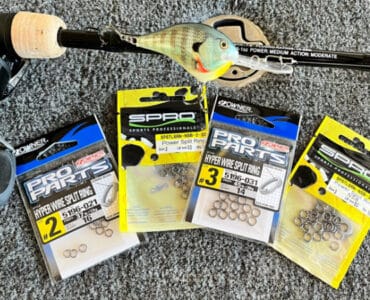
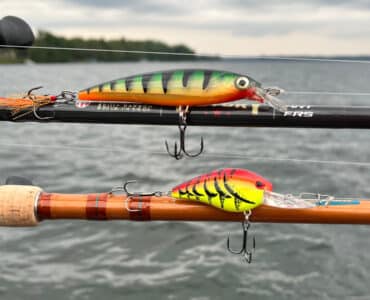
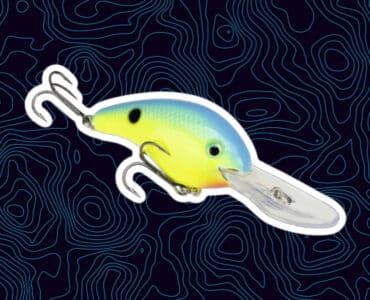
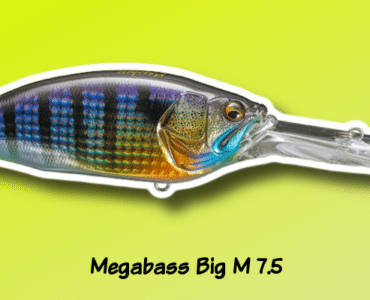








Add comment